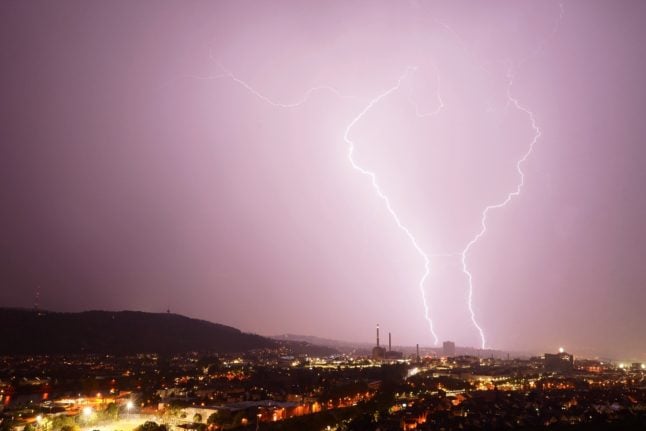Firefighters have been battling forest fires in several parts of Germany – and experts have warned that more could take hold as the warm weather continues.
In Thuringia, emergency services were trying to put out a huge blaze in a forest area of around 13 hectares on Tuesday.
The fire, which broke out for the first time on Easter Sunday, was considered to have been put out, but it has since flared up again in several places.
Residents have been asked to keep the windows and doors of the houses closed.
The continuing drought over Easter, which has seen temperatures in the high 20s and no rain, has aggravated the danger of forest fires in Germany.
On Tuesday, the environment ministry in Brandenburg announced that the risk had been pushed up to level 5 – the highest level – for the entire federal state.
A large forest fire erupted 20 kilometres north of Berlin early Monday morning. The blaze spread across an area of roughly 2.5 hectares before being brought under control by the fire brigade.
The cause of the fire is not known.
The German Weather Service (DWD) also marked the south of Mecklenburg-Western Pomerania, northern Saxony, eastern Saxony-Anhalt and the region around Celle in Lower Saxony as very high risk.
In Spremberg near Cottbus, a large fire broke out on Monday night, forest fire protection commissioner Raimund Engel said.
The fire had been reported shortly before midnight and extinguished in the early morning hours. But there were also problems with fires in other states, including Bavaria.
On Monday in Hersbruck, east of Nuremberg, a one hectare area of forest caught fire.
Fires across parts of Germany
Meanwhile, after a power line ruptured, two hectares of forest caught fire in a village east of Schwerin, Mecklenburg-West Pomerania. According to the police, a falling tree had damaged the high-voltage line. A total of 50 firefighters were at the scene.
In Lower Saxony, the fire brigade was still working on extinguishing two large fires on Tuesday. The fire near Vechta, which broke out on Easter Monday, was almost completely put out, a police spokeswoman said on Tuesday afternoon.
Around 150 fire fighters are still working to put out the fire. On the previous day, there had been up to 400 on site. The fire had burned on several hectares of land.
Some forests in the north of Saxony are have been closed off to people due to the very high risk of forest fires. The highest warning level – 5 – was in place on Tuesday.
'Very dry'
Meteorologist Florian Engelmann of the DWD said that April had been “very dry” again in Saxony so far. Up to and including Easter, an average of only 2.1 litres of precipitation per square meter fell in Saxony. According to the DWD, the long-term average for April is 58.4 litres per square metre.
The danger of forest fires is a little higher than in the previous year, warn the Lower Saxony Forests group.
“It’s because of the dry plants remaining from the past year”, explained spokesman Mathias Aßmann.
Experts said that higher winds increase the risk of wildfires because it can help spread the blaze.
People are being warned not to smoke in forests, or light any fires, warned Aßmann.
Cigarette butts thrown out of the car could lead to fires on embankments. “Citizens should call emergency services immediately in the event of a fire,” he said.
The situation is not expected to ease until later in the week when some rain is expected, according to forecasters.




 Please whitelist us to continue reading.
Please whitelist us to continue reading.
Member comments